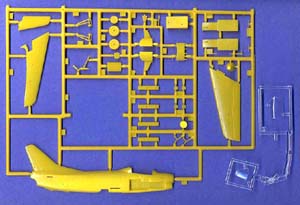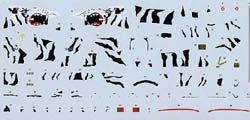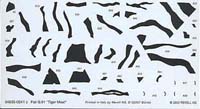Revell G. 91 "Tiger-Meet"
By Will Perry
 |

 |
 The Kit
The Kit Basic accuracy is pretty good - measurements of taped together parts scale out within a couple of millimeters of published dimensions. Comparing the kit to photos, a couple of areas stand out - the fairing behind the kit’s canopy looks too stubby lengthwise and too tall height wise. The intake mouth of the kit is just too small to my eye, and the drop tanks a bit anemic.
Basic accuracy is pretty good - measurements of taped together parts scale out within a couple of millimeters of published dimensions. Comparing the kit to photos, a couple of areas stand out - the fairing behind the kit’s canopy looks too stubby lengthwise and too tall height wise. The intake mouth of the kit is just too small to my eye, and the drop tanks a bit anemic. The molding is the biggest letdown. Engraved panel lines are inconsistent - crisp in some areas, soft and shallow in others. Simple rescribing will help, especially on top of the wings. My example also had noticeable sink marks on the upper surface of the wings. The scribing of some scoops and inspection panels was inexcusably sloppy, like an Eastern European kit from the Bad Old Days. Some areas have a surface texture rough to require some attention, lest they show up under the glossy final finish. The canopy molding is thin and clear.
The molding is the biggest letdown. Engraved panel lines are inconsistent - crisp in some areas, soft and shallow in others. Simple rescribing will help, especially on top of the wings. My example also had noticeable sink marks on the upper surface of the wings. The scribing of some scoops and inspection panels was inexcusably sloppy, like an Eastern European kit from the Bad Old Days. Some areas have a surface texture rough to require some attention, lest they show up under the glossy final finish. The canopy molding is thin and clear. Of course, it’s the decals that’ll make or break the model. You get lots - I counted around 100! – on two sheets, printed in Italy (Cartograph?). My sheets were perfectly registered. The decals look a tad thick and they’re a semi-matt finish. The majority of the decals are black tiger stripes and that lovely tiger face. The shapes on the decal sheet compare nicely to photos of the real plane. The instruction sheet includes good but small diagrams for decal location - scanning and blowing them up to 1/72 will make them more useful. Fingers crossed that the decals will fit, stick and settle down properly.
Of course, it’s the decals that’ll make or break the model. You get lots - I counted around 100! – on two sheets, printed in Italy (Cartograph?). My sheets were perfectly registered. The decals look a tad thick and they’re a semi-matt finish. The majority of the decals are black tiger stripes and that lovely tiger face. The shapes on the decal sheet compare nicely to photos of the real plane. The instruction sheet includes good but small diagrams for decal location - scanning and blowing them up to 1/72 will make them more useful. Fingers crossed that the decals will fit, stick and settle down properly.